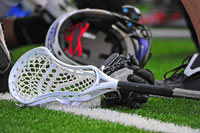 The following is a guest post by Joie Jager-Hyman, college consultant and author of B+ Grades, A+ Applications. Joie was an Assistant Director of Admissions at her alma mater, Dartmouth College, and has a Doctorate in Education Policy.
The following is a guest post by Joie Jager-Hyman, college consultant and author of B+ Grades, A+ Applications. Joie was an Assistant Director of Admissions at her alma mater, Dartmouth College, and has a Doctorate in Education Policy.
Many students dream of playing sports on the college level but most athletes don’t know how to get started with the college recruiting process. How can you tell if you’re good enough to play for a university? When should you reach out to coaches, how do you contact them and what’s the best way to introduce yourself? What role does academics play in the athletic recruiting process? These are just a few of the commonly asked questions I get from the students I work with as a college admissions consultant.
To give student-athletes a head start, I worked with Andrew Herman, who is an experienced university Athletic Director, on developing these ten basic steps to get the athletic recruitment ball rolling (pun intended) for my new book, B+ Grades, A+ Applications, which will be published by Ten Speed this summer.
1. Be Good at the Sport
In addition to beating school records, coaches are looking to recruit athletes who also spend time outside of school playing in tournaments and investing time in off-season training. For most sports, it’s also important to begin a weight-training program because college athletes are bigger, faster, and stronger than high school athletes.
2. Become Familiar with the NCAA Rules and Regulations
It’s easy to get confused when researching colleges individually since each NCAA classification (Division I, II and III) has their own rules and regulations. The NCAA website (www.ncaa.org) is a comprehensive resource for athletes to understand the different classifications, regulations, team rankings and academic requirements.
3. Find Role Models
It’s important to do research about how other student-athletes in a sport got recruited to learn more about the recruiting process. Additionally an athlete may want to research college athletes’ bios online and see if you can spot some themes and what they have done to get them where they are. (i.e. Did all the lacrosse players at your top-choice school play for a particular travel team or attend a camp?)
4. Get a Head Start
Most coaches begin recruiting athletes in their junior year of high school and most athletes commit to a college the following summer or fall. Since the athletic recruiting process is earlier than the regular college admissions timeline, by the end of sophomore year or beginning of junior year an athlete should start putting together a list of potential colleges that might be a good fit athletically and academically.
5. Get the Best Grades You Can
Although athletes are favored in the admissions process, they still have to meet the college’s minimum admission requirements to be accepted. It’s best to keep options open and cast a wide net when looking at colleges the beginning of the process because there is still time to improve as an athlete and a student.
6. Create a Resume to Send to Coaches
Take the initiative to send a resume to coaches at the schools of interest. Resumes should include: name and contact info, relevant physical characteristics, athletic and academic experience. Athletes can also include any outside hobbies or other extracurricular interests.
7. Write a Cover Letter
When sending resumes, an athlete should be sure to attach a brief cover letter introducing himself or herself to the coach. Keep the letter short and sweet, remembering to show enthusiasm for the school by including one or two details about the college and some information about personal academic interests. To ensure future contact, athletes should let the coach know their intentions to keep he or she updated on their progress.
8. Make a Video
Coaches use videos to see what athletes look like in action. The footage does not need to be professional, but it would be best to put together a short segment of a game or a series of clips that showcase personal athletic abilities relevant to the sport. Be sure to show it to people who can provide appropriate feedback before sending.
9. Send out Packets
A packet is the most important and comprehensive piece of information an athlete has to share with coaches. A packet should include: a resume, cover letter, video, and a copy of the transcript so the coach sees if an athlete meets the school’s academic profile. The earlier an athlete sends their packets (think winter of junior year), the more time they have to communicate with coaches.
10. Follow up
Athletes should be sure to follow-up with any coach that contacts them after they have sent their packets. The response should be brief and should express interest in learning more about the team, including questions about any camps or tournaments that they plan to attend and if the coach will also be there. If an athlete doesn’t hear from a coach within two weeks, he or she can write an email to inquire whether or not the coach has received the packet, kindly restating their interest in the school.
Dr. Jager-Hyman is an internationally acclaimed expert on the college admissions process. As an expert on college admissions, Joie has appeared on the CBS Early Show, New England Cable News, NPR and dozens of other radio programs. A graduate of Dartmouth College, Joie served as Assistant Director of Admissions for her alma mater, and then went on to complete a doctorate in education policy at Harvard University. Her latest book is, B+ Grades, A+ College Application: How to Present Your Strongest Self, Write a Standout Admissions Essay, and Get Into the Perfect School for You.

1 thought on “10 Steps to Help Your Child get Recruited by a Coach”